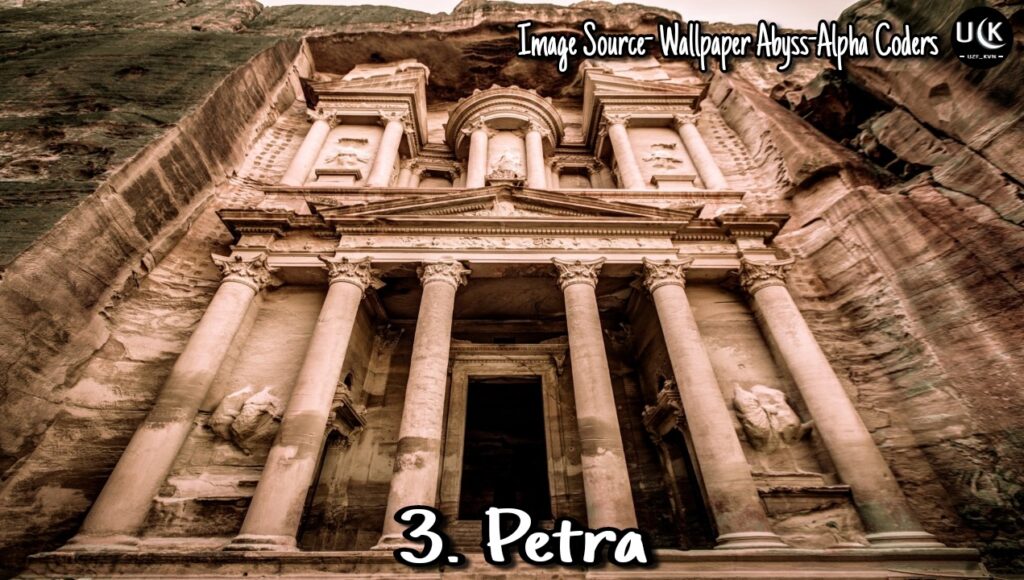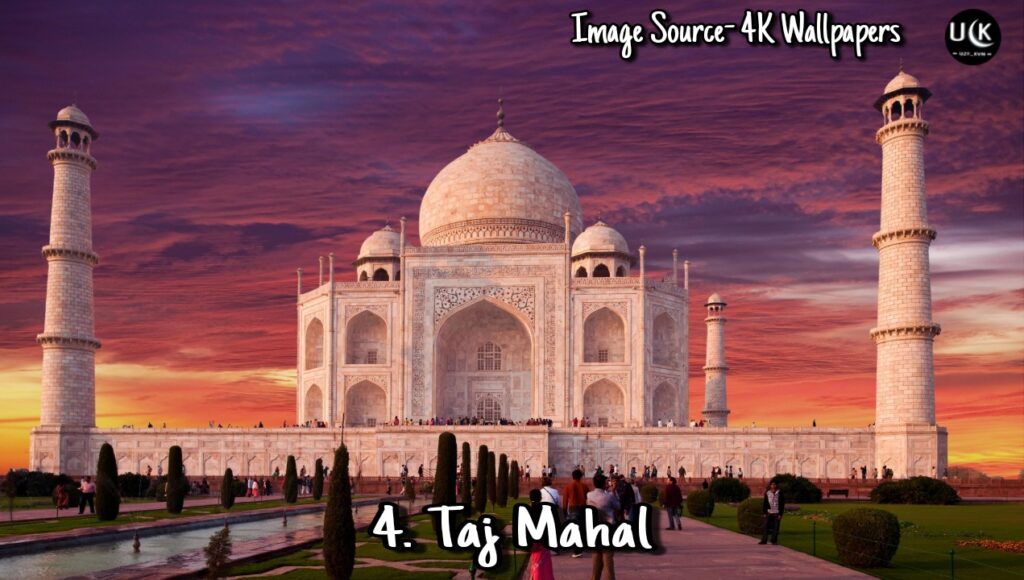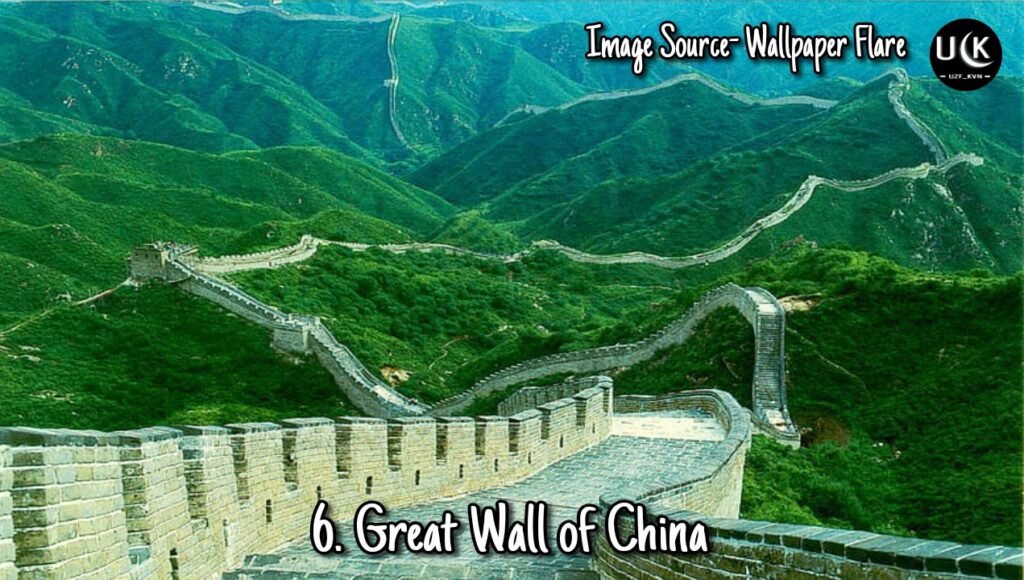Seven Wonders in 2023 is “The Colosseum, Machu Picchu, Petra, Taj Mahal , Christ the Redeemer Statue, Great Wall of China and Chichén Itzá” .

Table of Contents
1. The Colosseum
The Colosseum, also known as the Flavian Amphitheatre, is an oval amphitheater in the center of Rome, Italy. It is considered one of the greatest works of Roman architecture and engineering, and it is one of Rome’s most popular tourist attractions. The Colosseum was built in the first century AD, during the reign of the Roman emperors Vespasian and his son, Titus. It is the largest amphitheater in the world, and it could hold an estimated 50,000 to 80,000 spectators at its maximum capacity.
The Colosseum was used for a variety of events, including gladiator fights, animal hunts, and reenactments of famous battles. It was also used for theatrical performances, religious ceremonies, and other public spectacles. The Colosseum was made of concrete and stone, and it was adorned with marble and bronze. It had four levels of seating, and the seats were divided by social class, with the most expensive seats being reserved for the wealthy and the upper classes.
Over the centuries, the Colosseum has undergone significant damage due to natural disasters and human activities. However, it has undergone numerous renovations and restorations, and it is now a UNESCO World Heritage Site. Despite its age and the wear and tear it has sustained over the years, the Colosseum remains an iconic symbol of the power and grandeur of the Roman Empire.
Albert Einstein major discoveries- https://uzfkvn.com/knowledge/the-great-albert-einstein-born-to-death-journey-education-invention-discoveries-personal-life-achievements-and-death/
Seven Wonders in 2023, facts about the Colosseum:
1. The Colosseum was originally known as the “Amphitheatrum Flavium,” after the family of Roman emperors who commissioned its construction. It was later called the Colosseum because of a nearby statue of Nero, known as the “Colossus of Nero.”
2. The construction of the Colosseum began in 70 AD, and it was completed in 80 AD. It is estimated to have cost approximately 500 million sesterces, which was a significant amount of money at the time.
3. The Colosseum was built on the site of an artificial lake that was part of Nero’s palace, known as the “Domus Aurea.” After Nero’s death, the lake was filled in, and the Colosseum was built on top of it.
4. The Colosseum was designed to be a venue for large-scale entertainment events, and it was equipped with a number of features to make these events more spectacular. For example, it had a system of lifts and hoists that allowed animals and performers to be brought onto the stage, and it had a series of underground tunnels and chambers that were used to store props and equipment.
5. The Colosseum was used for gladiator fights, animal hunts, and other public spectacles for nearly 500 years. However, after the fall of the Roman Empire, the Colosseum fell into disrepair and was used as a quarry for building materials. It was not until the 18th and 19th centuries that the Colosseum began to be restored and preserved as a historical site.
6. Today, the Colosseum is one of Rome’s most popular tourist attractions, and it is visited by millions of people each year. It is also a symbol of the city of Rome and the Roman Empire, and it has been featured in numerous movies, TV shows, and other media.

2. Machu Picchu
Machu Picchu is a 15th-century Inca citadel located in the Andes Mountains of Peru, South America. It is located on a mountain ridge above the Urubamba Valley and is believed to have been built as an estate for the Inca emperor Pachacuti. The site is known for its beautifully crafted stone buildings, many of which are well-preserved, and for its stunning location, surrounded by lush vegetation and towering peaks. It is accessible by a train from the city of Cusco and by a hike along the Inca Trail, a famous trek that passes through several Inca sites along the way.
Machu Picchu is considered a masterpiece of architecture and engineering, and its construction and design reflect the ingenuity and sophistication of the Inca civilization. The site is made up of over 150 buildings, including temples, palaces, and residential areas. The most famous structures at Machu Picchu include the Temple of the Sun, the Temple of the Three Windows, and the Intihuatana, a stone pillar used for astronomical observations. The site is also home to a network of terraced farming areas and aqueducts, which were used to grow crops and manage water resources.
In addition to its architectural and engineering marvels, Machu Picchu is also known for its stunning natural setting. The site is located in a tropical forest at an altitude of 7,970 feet (2,430 meters) above sea level, and it is surrounded by towering peaks and lush vegetation. The region is home to a diverse array of flora and fauna, including orchids, hummingbirds, and spectacled bears.
Machu Picchu was abandoned by the Incas in the 16th century and was rediscovered by a westerner in 1911. Since then, it has become a major tourist destination, and it attracts thousands of visitors each year. The site is open to tourists from April to October, and it can be accessed by a train from the city of Cusco or by a hike along the Inca Trail. The Inca Trail is a popular trek that takes several days to complete and passes through several Inca sites along the way.
Machu Picchu is a symbol of the Inca Empire and is an important cultural and historical site in Peru. The site was declared a UNESCO World Heritage Site in 1983 and was named one of the New Seven Wonders of the World in 2007. It is also an important spiritual site for many people, and it is considered a sacred place by the indigenous people of the region.
Visiting Machu Picchu is a once-in-a-lifetime experience for many people, and it is a must-see destination for anyone traveling to Peru. There are several ways to visit the site, including by train or by hiking the Inca Trail. Tourists can also visit other nearby Inca sites, such as the Sacred Valley and the city of Cusco.
The site is well-preserved and is a testament to the skill and ingenuity of the Inca people. It is a popular destination for tourists from all over the world, and it is considered one of the most important cultural and historical sites in South America.

3. Petra
Petra is an ancient city located in present-day Jordan. It is a UNESCO World Heritage Site and is known for its rock-cut architecture, which was carved into the sandstone cliffs by the Nabataeans, an Arab people who lived in the region from the 4th century BC to the 2nd century AD. The city was an important hub for trade and served as the capital of the Nabataean kingdom. Some of the most famous landmarks in Petra include the Treasury, the Monastery, and the Royal Tombs. Visitors to Petra can explore the ancient city on foot or by camel, and there are many guided tours available. The city is a popular tourist destination and is considered one of the wonders of the world.
Interesting Points of Petra:
1. The Nabataeans were skilled engineers and were able to create a complex system of channels, cisterns, and reservoirs to collect and store water in the arid desert region where Petra is located. This allowed them to create a thriving city in an area that would have otherwise been inhospitable.
2. Petra was an important center for the production of incense, which was used in religious rituals and was highly prized in the ancient world. The city was also known for its production of other luxury goods, such as spices and perfumes.
3. The city was conquered by the Roman Empire in 106 AD, and it continued to thrive under Roman rule. It was an important stop on the trade routes that connected Arabia with the Mediterranean world.
4. Petra’s location made it difficult to access, and as a result, it was largely forgotten by the Western world until it was rediscovered in the 19th century by Swiss explorer Johann Ludwig Burckhardt. Since then, it has become a popular tourist destination, attracting visitors from all over the world.
5. Petra is located in a desert region, so it can be very hot during the day. It is recommended to visit early in the morning or late in the afternoon to avoid the heat. It is also a good idea to bring plenty of water and sunscreen.
6. The city of Petra is believed to have been founded in the 6th century BC, but it was the Nabataeans who really made it a thriving metropolis. The Nabataeans were a skilled and sophisticated culture, and they developed a system of governance and a system of writing that allowed them to manage the city and its trade effectively.
7. Petra was an important center of the worship of the god Dushara, and many of the buildings in the city were dedicated to him. The Nabataeans also practiced other religions, including the worship of the Greek gods.
8. In addition to the rock-cut architecture that Petra is famous for, the city also had more traditional buildings made of brick and stone. These included houses, temples, and public buildings such as markets and theaters.
9. The city was laid out in a series of terraces that were connected by a series of steps and pathways. The pathways were lined with columns, and the city was surrounded by a wall that protected it from potential invaders.
10. Petra was designated a UNESCO World Heritage Site in 1985 and has received many accolades over the years for its cultural and historical significance. It is considered one of the most important ancient sites in the Middle East, and it continues to draw visitors from all over the world.

4. Taj Mahal
The Taj Mahal is a white marble mausoleum located in Agra, India. It was built by the Mughal Emperor Shah Jahan in memory of his favorite wife, Mumtaz Mahal, who died during childbirth in 1631. The Taj Mahal is considered one of the most beautiful and iconic buildings in the world. It is also one of the Seven Wonders of the World. The Taj Mahal was built over a period of 22 years by a team of thousands of artisans and craftsmen, and it is known for its intricate carvings, inlaid with precious stones, and beautiful gardens. It is a popular tourist destination, attracting millions of visitors each year.
Interesting about The Taj Mahal:
1. The Taj Mahal is located on the south bank of the Yamuna River in Agra, India, about 125 miles south of Delhi. It is located in a complex that includes other buildings, such as a mosque and a guest house, as well as gardens.
2. The Taj Mahal is built in the Mughal architectural style, which combines elements of Persian, Indian, and Islamic design. It is made of white marble and is adorned with intricate carvings, inlaid with precious stones, and decorated with calligraphy.
3. The main chamber of the Taj Mahal contains the tombs of Shah Jahan and Mumtaz Mahal. The tombs are surrounded by a beautifully decorated chamber that is adorned with inlaid stone and calligraphy.
4. The Taj Mahal is surrounded by beautiful gardens, which are divided into four sections by water channels. The gardens are planted with a variety of flowers and trees, and they include fountains and other water features.
5. The Taj Mahal is a UNESCO World Heritage site, and it is considered one of the finest examples of Mughal architecture in the world.
6. The Taj Mahal is a popular tourist destination, and it attracts millions of visitors each year.
7. The Taj Mahal was built over a period of 22 years, from 1632 to 1654. It was commissioned by the Mughal Emperor Shah Jahan as a memorial to his favorite wife, Mumtaz Mahal, who died during childbirth in 1631.
8. The Taj Mahal was built by a team of thousands of artisans and craftsmen, including masons, carvers, inlayers, and calligraphers. Many of these craftsmen were brought to Agra from other parts of the Mughal Empire, and some were even brought in from other countries.
9. The Taj Mahal is made of white marble, which was brought from a quarry in Makrana, Rajasthan. The marble was then carved and inlaid with precious stones, such as diamonds, emeralds, and rubies, to create the intricate designs that adorn the building.
10. The Taj Mahal is surrounded by beautiful gardens, which are divided into four sections by water channels. The gardens are planted with a variety of flowers and trees, and they include fountains and other water features. The gardens were designed to be a paradise on earth, and they are intended to symbolize the four rivers of Paradise in Islamic tradition.
11. The Taj Mahal has undergone several restoration projects over the years, in order to preserve and protect the building from the effects of pollution and other environmental factors. One of the most recent restoration projects was completed in 2010, and it included the cleaning and repair of the marble and the restoration of the gardens.
12. The Taj Mahal is a popular tourist destination, and it attracts millions of visitors each year. It is open to the public every day except Friday, and it is advisable to arrive early in the morning to avoid the crowds. Visitors can take guided tours of the building and the gardens, or they can explore on their own.

5. Christ the Redeemer Statue
The Christ the Redeemer statue is a large Art Deco-style statue of Jesus Christ in Rio de Janeiro, Brazil. It is located at the peak of the 700-meter (2,300-foot) Corcovado mountain in the Tijuca Forest National Park overlooking the city. The statue, which is made of reinforced concrete and covered in soapstone, stands 38 meters (125 feet) tall, including its pedestal, and weighs 635 metric tons. It is one of the most famous and iconic landmarks in Brazil, and is a major tourist attraction in Rio de Janeiro.
The idea for the statue was first proposed in the mid-1850s, but it was not until the 1920s that a campaign to build the statue began in earnest. The project was led by the Catholic Circle of Rio de Janeiro, with funding provided by Brazilian Catholics. The statue was designed by the French sculptor Paul Landowski, and was completed in 1931. It was declared one of the World in 2007.
Details about the Christ the Redeemer statue:
1. The statue is located about 2,300 feet above sea level, and can be reached by either a train or a van from the base of the mountain. There is also a hiking trail to the top of the mountain, which takes about an hour to reach the statue.
2. The statue has become a symbol of Christianity in Brazil and a cultural icon of Rio de Janeiro. It is visited by millions of tourists every year, and has become a popular spot for tourists to take photos and enjoy the panoramic views of the city.
3. In addition to being a major tourist attraction, the statue also serves as a cultural and spiritual center for the city. It is the site of many religious ceremonies and events, including Easter Mass and the celebration of Corpus Christi.
4. The statue has undergone several renovations and repairs over the years to maintain its structural integrity and appearance. In 2010, a major restoration project was completed to repair damage caused by lightning strikes and exposure to the elements.
5. In addition to being one of the New Seven Wonders of the World, the Christ the Redeemer statue is also a UNESCO World Heritage Site, recognized for its cultural and historical significance.

6. Great Wall of China
The Great Wall of China is a series of fortifications that were built, rebuilt, and maintained over many centuries across northern China in an effort to protect the Chinese Empire and its territories from various invaders and nomadic groups. The wall is over 13,000 miles long and is one of the most iconic and well-known landmarks in the world. It was designated as a UNESCO World Heritage Site in 1987 and is a popular tourist destination. The wall was built primarily of brick, tamped earth, and wood, but some sections were constructed using stone, granite, and other materials. It was originally built during the Warring States period (475-221 BC) and expanded and reinforced during the Ming Dynasty (1368-1644).
Details about the Great Wall of China:
1. The Great Wall was not constructed in a single effort, but rather was built and maintained over many centuries by different dynasties and rulers. It is believed to have been started as early as the 7th century BC and was expanded and reinforced over time to meet the changing needs and threats faced by the Chinese Empire.
2. The Great Wall was built to protect China from various invaders and nomadic groups, such as the Mongols, who posed a constant threat to the Chinese Empire. It served as a physical barrier and a psychological deterrent, as the wall was often seen as a symbol of the power and strength of the Chinese Empire.
3. The Great Wall was not always effective at defending China, as it was frequently breached by invaders. However, it did serve as a useful tool for controlling the movement of people and goods within China, as well as for tax collection and other purposes.
4. The Great Wall is made up of many different sections and fortifications, each with its own unique characteristics and history. Some of the most famous sections of the Great Wall include the Mutianyu section, which is known for its beautiful scenery, and the Badaling section, which is one of the most popular tourist destinations.
5. The Great Wall is not visible from space with the naked eye, as is a common misconception. However, it is visible from low Earth orbit and from the moon with the aid of a telescope or other instruments.
6. The construction of the Great Wall involved a massive effort, with hundreds of thousands of workers, including soldiers, prisoners, and conscripted laborers, working on the project over many years. The construction of the wall was a major undertaking and required the use of advanced engineering techniques and materials, such as the use of bricks and tamped earth for the foundations and the use of stone and granite for the outer layers of the wall.
7. The Great Wall was not always a continuous structure, but rather was made up of many different sections that were connected by gates and watchtowers. These sections varied in length and in the materials used in their construction, depending on the local terrain and the resources available.
8. The Great Wall is not the only fortification in China, and there were many other walls and fortifications built throughout the country to protect against invaders and nomadic groups. These include the Great Jin Wall, which was built in the 12th century to protect against the Jurchens, and the Ming Dynasty Great Wall, which was built in the 14th and 15th centuries to protect against the Mongols.
9. The Great Wall has undergone many renovations and repairs over the centuries, and many sections of the wall have been lost or destroyed due to natural disasters, neglect, and other factors. In recent years, there has been a concerted effort to preserve and restore the Great Wall, with various projects underway to repair and rebuild sections of the wall and to protect it from further deterioration.
10. The Great Wall is a popular tourist destination, with millions of visitors each year. In addition to the wall itself, there are many other attractions in the surrounding areas, including museums, temples, and other historical sites. There are also many options for visitors to experience the Great Wall, including hiking, cable car rides, and even bungee jumping in some areas.

7. Chichén Itzá
Chichén Itzá is a pre-Columbian archaeological site located in the Yucatán Peninsula of Mexico. It was a major city of the ancient Maya civilization and a center of trade, politics, and religion. The site contains several important structures, including the Pyramid of Kukulcan , the Temple of the Warriors, and the Great Ball Court. Chichén Itzá was designated a World Heritage Site by UNESCO in 1988 and is now a popular tourist destination in Mexico. The name “Chichén Itzá” means “At the mouth of the well of the Itza” in the Maya language.
Chichén Itzá was a major center of the Maya civilization from the Late Classic period (600-900 AD) to the Terminal Classic period (800-900 AD). The city was a center of trade, with goods flowing in from all over the Maya world. It was also a political and religious center, with a number of important structures dedicated to the worship of the Maya gods. One of the most famous structures at Chichén Itzá is the Pyramid of Kukulcan, also known as the Temple of Kukulcan. This pyramid is a stepped pyramid with a series of terraces and a temple at the top. The pyramid is decorated with carvings of serpents, and it is believed to have been used for ceremonies and sacrifices to the Maya god Kukulcan. Other notable structures at Chichén Itzá include the Temple of the Warriors, a large complex of buildings decorated with carvings of warriors and sacrificial victims, and the Great Ball Court, where the Maya played a game similar to modern-day basketball. The site also contains a number of cenotes, natural sinkholes that were used for water supply and ritual purposes.
Chichén Itzá was abandoned by the Maya around the 10th century AD, but it was rediscovered by the outside world in the late 19th century. Today, it is a popular tourist destination in Mexico and is visited by millions of people each year.
Thanks For Reading Complete Blog
Read Some More An Article







GOOD